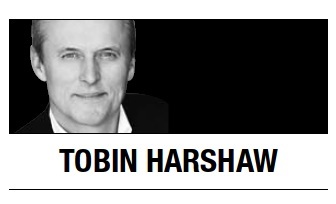
Defense alliances are complicated things, but in the U.S. we have bipartisan clarity on one thing: Our allies are letting us down.
“If Saudi Arabia was without the cloak of American protection,“ Republican frontrunner Donald Trump said this weekend, ”I don’t think it would be around.”
He has also shamed America’s top defense partners in Asia: Japan and South Korea. “We have 28,000 people on the border separating South Korea from this maniac in North Korea. We get nothing,” he said. “We get nothing. They’re making a fortune.”
President Barack Obama has a cooler demeanor, but the same icy attitude toward longstanding military partners. “Free riders aggravate me,” he told the Atlantic’s Jeffrey Goldberg, not long after informing U.K. Prime Minister David Cameron that the longtime “special relationship” between the nations was at risk unless the Brits met the NATO goal of spending 2 percent of GDP on the military.
He also accused the Gulf Arab nations of “pushing us to act but then showing an unwillingness to put any skin in the game.”
To some extent, this criticism is valid. Even before being pinched by the global financial crisis, most NATO nations repeatedly cut their defense budgets, failing to meet the 2 percent benchmark. On the other hand, this viewpoint — part of what my colleague Eli Lake calls the Obama-Trump Doctrine — ignores some facts.
Japan, Korea and European countries to some extent subsidize the U.S. troop presence inside their borders; Germany pays over $1 billion and Japan upped its 2016 contribution by 1.4 percent, to $1.6 billion. Recall, too, that the allies have been there for American-initiated wars in Afghanistan and Iraq.
Both men also seem to ignore that 2015 may be seen as the year the allies moved out of Mom and Dad’s basement and took some responsibility.
Consider NATO. According to the latest annual report from Secretary General Jens Stoltenberg, 16 members spent more on defense last year than in 2014. While the Baltic states and other smallish countries living in Russia’s shadow generally had the largest percentage increases, Germany has approved boosts of $2.1 billion per year through 2019, and the U.K. has pledged an additional $18 billion over a decade.
More important, perhaps, NATO nations are spending a lot more on actual fighting equipment rather than staffs and pensions — eight allocated more than 20 percent of their military budgets to hardware. Readiness is also being stressed: Last year’s Exercise Trident Juncture in Southern Europe was the largest joint drill in over a decade, involving 36,000 troops, 140 aircraft and 60 ships.
Just as Russia has shaken Europe out of its defense stupor, so have China and North Korea energized the rest of East Asia. Japan has allocated a record $42 billion in fiscal 2016 (although a sluggish yen means its global spending power has increased at a lower rate). The budget includes purchases of six next-generation Lockheed-Martin F-35s and three Global Hawk drones, and funding for building a new guided missile destroyer.
More than money, though, Japan’s seriousness should be judged by its structural reforms, arguably the most significant since its self-defense force was created after World War II. Last April, Tokyo and Washington reached significant agreements on increased Japanese support for ballistic-missile defense, maritime security and intelligence sharing. Japanese defense forces can now use military action to protect the U.S. even if their own islands are not under direct threat. Prime Minister Shinzo Abe is pushing other measures to loosen restrictions, and continues to fight local opposition to building a new U.S. base on the island of Okinawa, to which Japan will contribute $3 billion.
South Korea, contra Trump’s assertion that ”we get nothing,“ contributes $866 million a year for the U.S. presence. No, that doesn’t offset the full expense for the 29,000 Americans stationed there. But the Koreans also have half a million troops of their own protecting against Kim Jong Un’s hungry hordes. Seoul has steadily expanded defense spending this decade, and is now set for a binge, increasing outlays by $215 billion between now and 2020, or 7 percent annually. The big-ticket item under consideration is a new air- and missile-defense system, a homemade substitute for deploying America’s Thaad missile shield, which has been held up by Chinese objections.
The Gulf Arabs, worried about Iran’s oil windfall after the nuclear deal lifts sanctions, seem intent on getting “skin in the game.” I’ve written repeatedly on this — see here and here — but major recent arms buys include 28 Apache helicopters by Saudi Arabia, 24 French-made Rafale fighters by Qatar, two Boeing Globemaster transport planes by the United Arab Emirates Patriot missile batteries by Kuwait. While the Gulf Cooperation Council’s war against the Houthi rebels has been carried out with a minimum of competence, neither Obama nor Trump can deny that it showed some initiative.
The U.S. shouldn’t be the world’s unpaid security guard. The ”peace dividend“ everyone hoped for after the fall of the Soviet Union was largely enjoyed by others, especially after the 9/11 attacks pushed America into one war of necessity and another of choice. Yet there are signs that allies in Asia, Europe and the Middle East are starting to understand that the bill for the Pax Americana has come due.
By Tobin Harshaw
Tobin Harshaw writes editorials on national security, military affairs and education. He was previously an editor with the op-ed page of the New York Times and the paper’s letters editor. — Ed.
(Bloomberg)








![[Weekender] Korea's traditional sauce culture gains global recognition](http://res.heraldm.com/phpwas/restmb_idxmake.php?idx=644&simg=/content/image/2024/11/21/20241121050153_0.jpg)